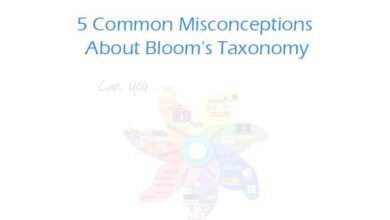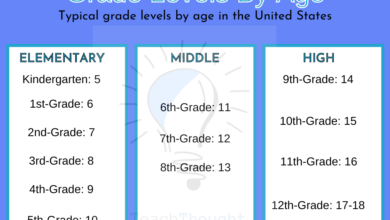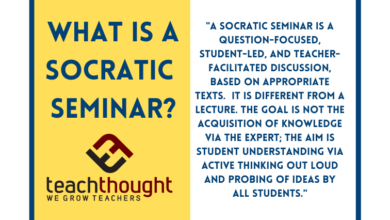126 Digital Learning Verbs Based on Bloom’s Taxonomy –
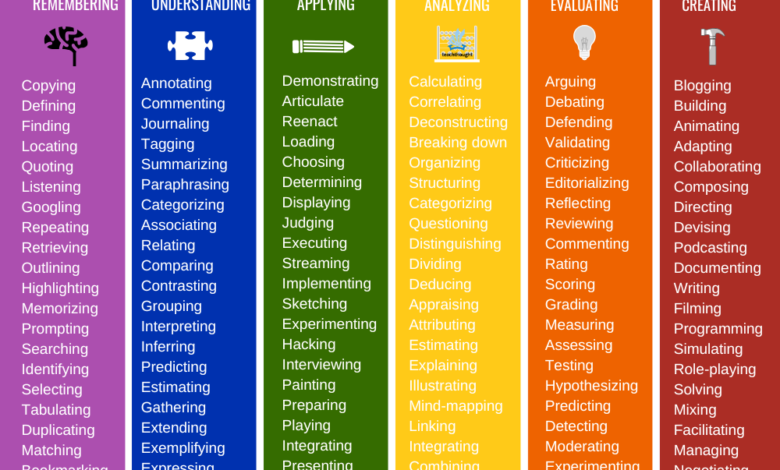
by TeachThought Staff
At TeachThought, we’re interested supporters of any learning taxonomy.
(We even created our own, the TeachThought Learning Taxonomy.)
Learning taxonomies help us think about how learning happens, highlighting that there are many ways to frame thinking.
Bloom’s Digital Taxonomy Verbs adapt Bloom’s original cognitive framework for digital learning, helping K-12 teachers integrate technology while building essential thinking skills. The taxonomy organizes digital actions into levels like remembering, understanding, applying, analyzing, evaluating, and creating, each with tech-based verbs that support specific learning goals.
This means that we can have taxonomies for differentiation and taxonomies for thinking and taxonomies for tasks and assessment–so many possibilities for examining the actual process of thinking, learning, and the application of each.
This leads to cool visuals–Bloom’s Taxonomy posters, for example.
It can also lead to tools that help to design lessons, units, and assessments–Bloom’s Taxonomy verbs work well here.
You can get a ready-for-the-classroom version of Bloom’s Digital Taxonomy for $6.95.
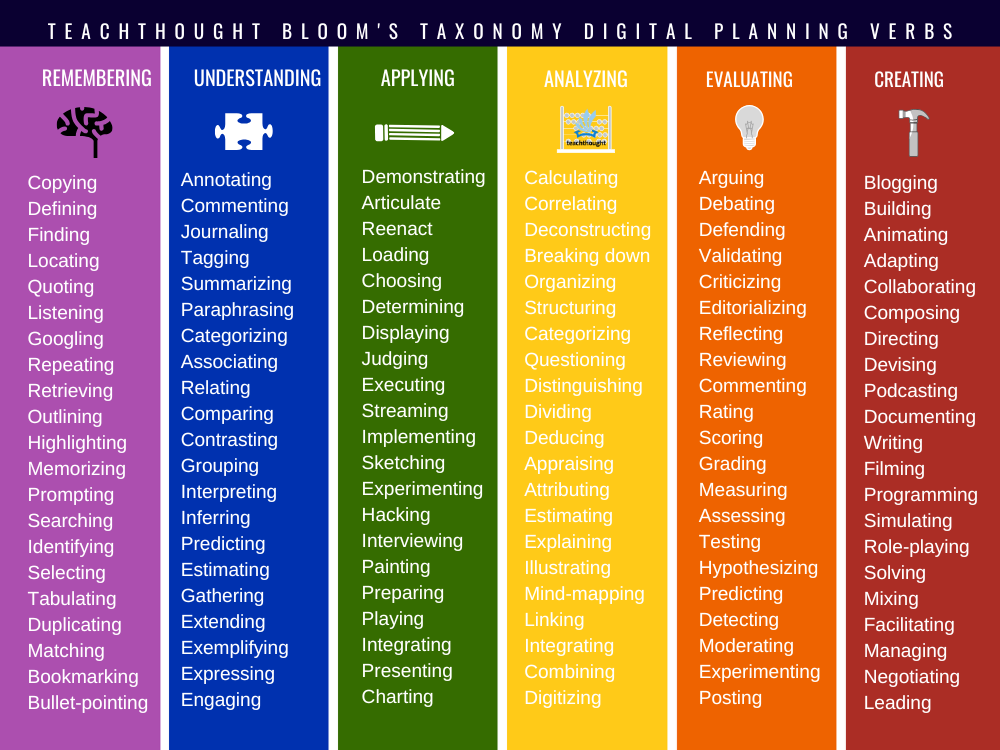
This kind of framework—merging Bloom’s Taxonomy with digital and social tools—can help teachers make more intentional choices about how students engage with content in modern learning environments. In the graphic below, we’ve organized 126 “power verbs” commonly associated with digital learning into the familiar levels of Bloom’s: Remember, Understand, Apply, Analyze, Evaluate, and Create. You’ll see verbs like moderate, duplicate, blog, build wikis, and podcast—all examples of how technology can shape and extend student thinking.
It’s important to understand, though, that these categories aren’t rigid. A single verb could arguably appear at multiple levels depending on the context. Blogging, for example, might involve simple recall in one assignment and higher-order synthesis or evaluation in another. That flexibility is part of what makes Bloom’s Taxonomy useful—but also why it’s never a perfect fit.
Ultimately, the value isn’t in getting each verb in exactly the right place. The value is in thinking carefully about the kinds of thinking we’re asking students to do—and how digital tools can deepen or extend that thinking in meaningful ways. Whether or not you use this exact framework, the exercise of connecting cognitive processes to digital tasks is a powerful way to sharpen your planning and better support critical thinking in your classroom.
The result is a tool that can help teachers think about the levels of higher-order thinking that go into these kinds of activities and projects. To be clear, just because a verb is in one category doesn’t mean it can’t also be used at higher or lower levels of thinking (i.e., appear in other categories of Bloom’s Digital Taxonomy).
Looking for a traditional version of Bloom’s verbs? View our Bloom’s Taxonomy Verbs for Teaching and Planning.
Want to see how these verbs align visually with thinking levels? Explore our Bloom’s Digital Taxonomy Chart.
In fact, there is a significant amount of subjectivity and editorializing that goes into any kind framework that purports to outline how thinking happens. It’s not an exact science. Nonetheless, just the fact that we’re exploring thinking and digital tasks and student work together is at least as valuable as any single framework in and of itself.
By doing this kind of work, we collectively–you, TeachThought, administrators, schools, researchers, universities, etc.–can develop ‘fluency’ in the murky and abstract field of applied neurology. We can begin to understand how understanding happens.
Bloom’s Digital Taxonomy Power Verbs
Hopefully you find the graphic useful to explore, discuss, plan, and otherwise participate in Bloom’s Digital Taxonomy.
You can also find a classroom-ready version of our Bloom’s Taxonomy Digital Planning Verbs & Cards to shorten prep time and focus on broader lesson and unit planning strategies for your students.
If you have any verbs you’d like to see added to the chart, let us know in the comments below.
126 Bloom’s Taxonomy Verbs For Digital Learning
Remembering
- Copying
- Defining
- Finding
- Locating
- Quoting
- Listening
- Googling
- Repeating
- Retrieving
- Outlining
- Highlighting
- Memorizing
- Prompting (ChatGPT, for example)
- Searching
- Identifying
- Selecting
- Tabulating
- Duplicating
- Matching
- Bookmarking
- Bullet-pointing
Understanding
- Annotating
- Commenting
- Journaling
- Tagging
- Summarizing
- Paraphrasing
- Categorizing
- Associating
- Relating
- Comparing
- Contrasting
- Grouping
- Interpreting
- Inferring
- Predicting
- Estimating
- Gathering
- Extending
- Exemplifying
- Expressing
- Engaging
Applying
- Demonstrating
- Articulate
- Reenact
- Loading
- Choosing
- Determining
- Displaying
- Judging
- Executing
- Streaming
- Implementing
- Sketching
- Experimenting
- Hacking
- Interviewing
- Painting
- Preparing
- Playing
- Integrating
- Presenting
- Charting
Analyzing
- Calculating
- Correlating
- Deconstructing
- Breaking down
- Organizing
- Structuring
- Categorizing
- Questioning
- Distinguishing
- Dividing
- Deducing
- Appraising
- Attributing
- Estimating
- Explaining
- Illustrating
- Mind-mapping
- Linking
- Integrating
- Combining
- Digitizing
Evaluating
- Arguing
- Debating
- Defending
- Validating
- Criticizing
- Editorializing
- Reflecting
- Reviewing
- Commenting
- Rating
- Scoring
- Grading
- Measuring
- Assessing
- Testing
- Hypothesizing
- Predicting
- Detecting
- Moderating
- Experimenting
- Posting
Creating
- Blogging
- Building
- Animating
- Adapting
- Collaborating
- Composing
- Directing
- Streaming
- Podcasting
- Documenting
- Writing
- Filming
- Programming
- Simulating
- Role-playing
- Solving
- Mixing
- Facilitating
- Managing
- Negotiating
- Leading
Another version of the graphic from Global Digital Citizen appears below.
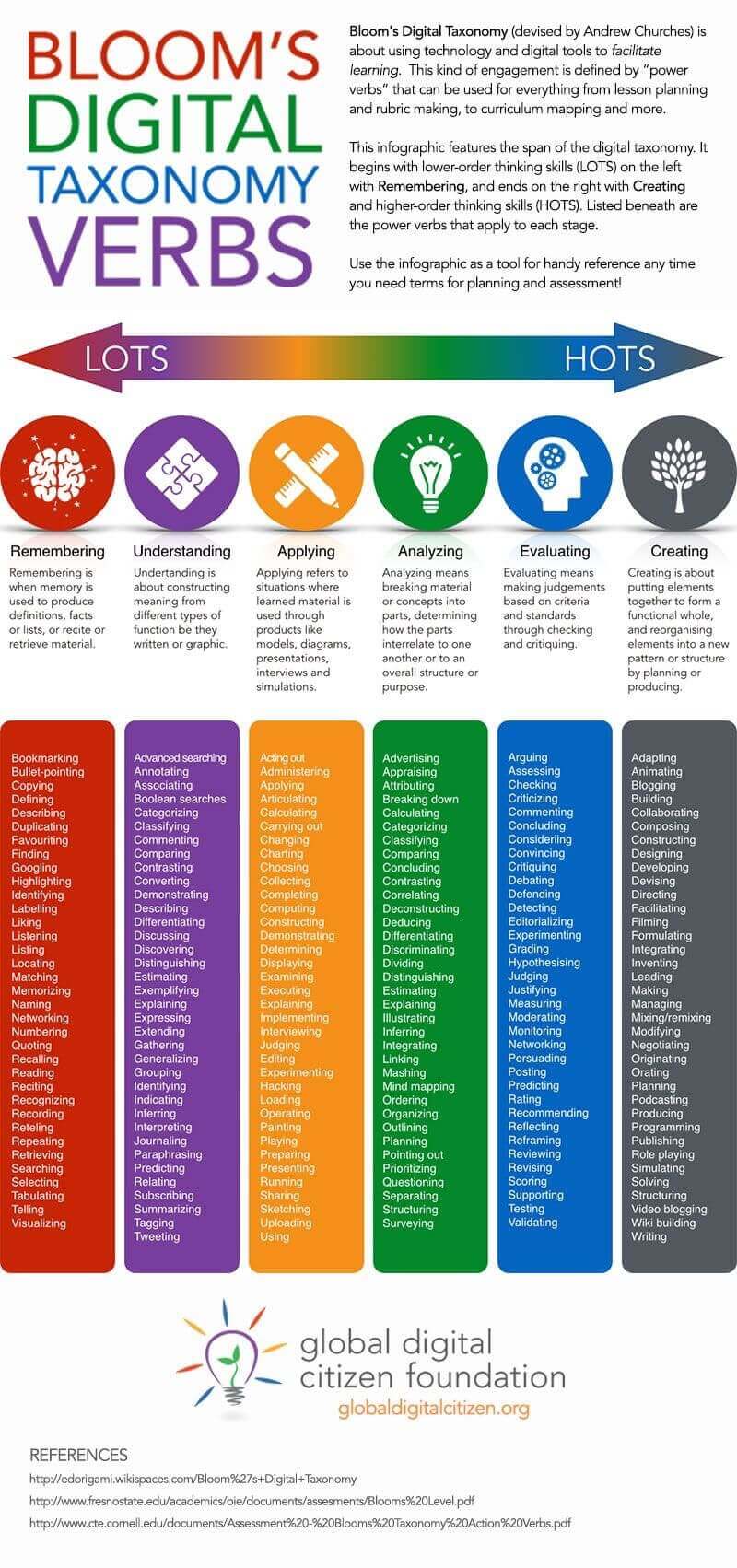
Source link

